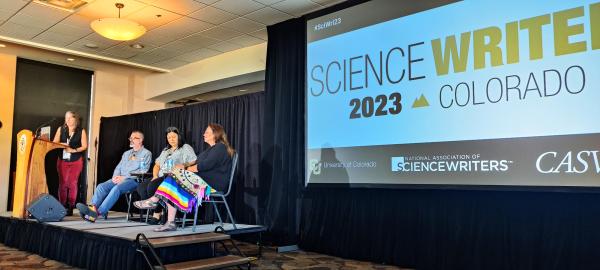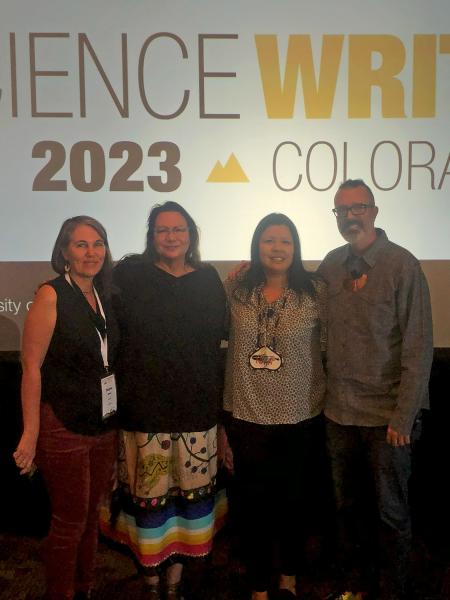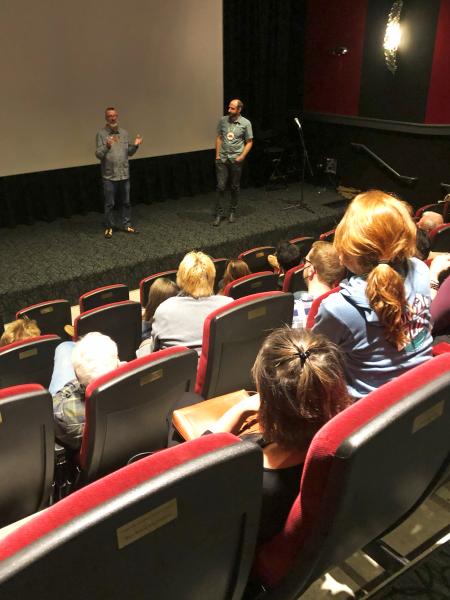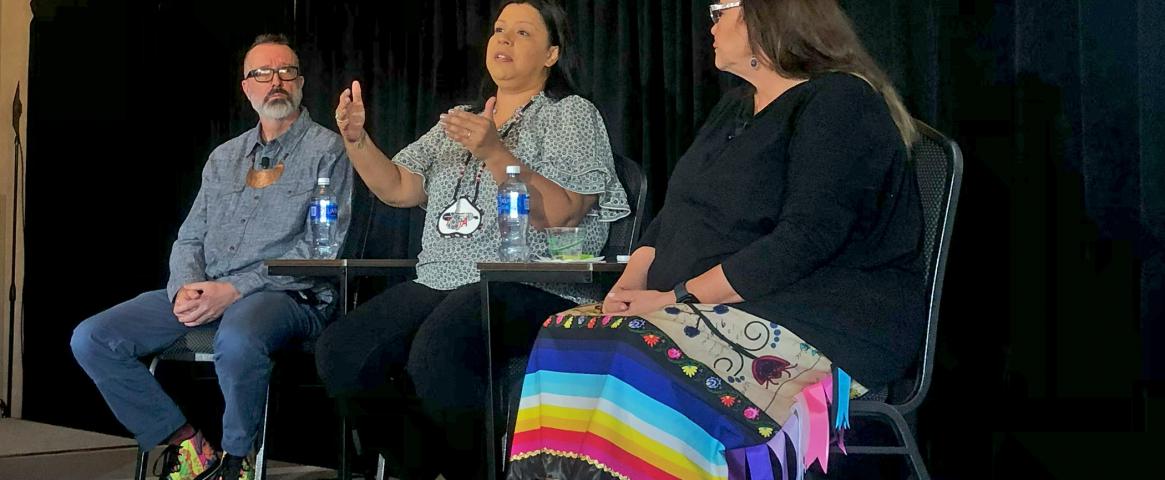Story by Rasha Aridi
Photography by Ankita Arora
The first amendment in the United States’ Constitution states that Congress will not abridge freedom of the press — a key tenet of democracy that protects journalists’ missions to hold truth to power, free of government influence and censorship. But of the 574 federally recognized Tribes, only five have laws that protect a free and independent press.
“One thing I've learned is that Indigenous communities, we really can't rely on mainstream press to tell our stories with accuracy and with authenticity. It’s really on us to do that,” said panelist Bryan Pollard. “But our jobs become much, much harder when we don’t have an independent voice.”
At the ScienceWriters2023 national meeting in Boulder, Colorado, freelance journalist Virginia Gewin moderated a plenary session called “Indigenous Media Freedom” (#TribalPressFreedom) on October 9. The panel consisted of three Indigenous journalists: Pollard, grant operations manager at the Associated Press; Francine Compton, associate director of the Indigenous Journalists Association; and Jodi Rave Spotted Bear, founder and director of the Indigenous Media Freedom Alliance. The plenary was organized in partnership with the Indigenous Journalists Association with NASW member Virginia Gewin.
 Moderator Virginia Gewin and panelists Bryan Pollard, Francine Compton, and Jodi Rave Spotted Bear listen to audience questions at ScienceWriters2023. (Ankita Arora for NASW)
Moderator Virginia Gewin and panelists Bryan Pollard, Francine Compton, and Jodi Rave Spotted Bear listen to audience questions at ScienceWriters2023. (Ankita Arora for NASW)
The session began with a 17-minute preview of the documentary Bad Press — which follows the fight to regain press freedoms in the Muscogee Nation in Oklahoma. In 2018, the nation’s government overturned those protections in an emergency session. The Tribe’s news outlet, Mvskoke Media, became subject to government oversight and censorship overnight, making it impossible to truthfully report on Tribal news and to hold those in power accountable.
The screening was met with a round of applause before each of the panelists described their own experiences navigating limited press freedoms. Spotted Bear shared her story of moving back to the Fort Berthold Reservation — home to the Mandan, Hidatsa, and Arikara Nations — in North Dakota. After nearly 20 years in mainstream media, she worked as the executive director of the Tribe’s radio station and newspaper.
“I figured I might as well step into the lion's den and see what that was like, if I really wanted to see change in my own community,” she said.
But without protected press freedom, she couldn’t fully do her job. Years ago, in a debate during an open meeting, she asked council leaders to provide her team media packets so they could accurately report on agendas, since most decisions were being made behind the scenes. That debate was broadcasted on the radio station, KMHA, across the reservation and beyond.
“After that live radio debate, which was on a Thursday, I showed up that week on Monday and I was fired by one of our board members,” she said. “That had prompted me to create the Indigenous Media Freedom Alliance.”
 Moderator Virginia Gewin with panelists Bryan Pollard, Francine Compton, and Jodi Rave Spotted at the NASW plenary "Indigenous Media Freedom" during ScienceWriters2023. (Ben Young Landis/NASW)
Moderator Virginia Gewin with panelists Bryan Pollard, Francine Compton, and Jodi Rave Spotted at the NASW plenary "Indigenous Media Freedom" during ScienceWriters2023. (Ben Young Landis/NASW)
In the United States, Indigenous nations are sovereign, so federal and state powers are limited – including the First Amendment.
“I think it's really good that Tribes have that veil to protect themselves from outside colonial forces. But that veil can also be used to shield the activities of the government from its own people, and I think that's where it gets really dangerous,” Pollard said. “When you don't have an independent press and when you don't have laws to protect that press's independence, that's when that veil becomes very opaque.”
Organizations like the Indigenous Media Freedom Alliance and the Indigenous Journalists Association are advocating for Indigenous press freedoms. One way, Compton says, is by suggesting interventions to the United Nations.
“We're talking to Indigenous peoples from around the world about how they're being suppressed, how their press freedoms are being challenged, or possibly non-existent, where they are,” Compton says.
The panel wrapped up with next steps and hopes for the future. Compton invited journalists to join the Indigenous Journalists Association, which non-Indigenous folks can also join as associate members. Additionally, if journalists are going to report on Indigenous issues, Pollard says to “do your homework” and avoid treating these stories like spot news — they are more complex than that and require an understanding of the culture and history. Indigenous communities are among the most overlooked and marginalized communities in the world, so stories should be told with the utmost care.
Because of that, the panelists also encouraged non-Indigenous journalists to collaborate with Tribal media outlets on stories about their respective Nations, and to do so in a way that empowers them — such as through funding, since Tribal newsrooms tend to have limited resources — and by understanding where that Nation’s press freedoms stand.
 NASW President Cassandra Willyard listens to Byran Pollard and Tyler Graim speak on stage at a showing of the documentary film "Bad Press" in Boulder. (Ben Young Landis/NASW)
NASW President Cassandra Willyard listens to Byran Pollard and Tyler Graim speak on stage at a showing of the documentary film "Bad Press" in Boulder. (Ben Young Landis/NASW)
Rasha Aridi (rashaaridi.com) is a radio producer at Science Friday, based in Washington, D.C. She has also reported for NPR, Science Vs, Smithsonian, and Science magazine.
Ankita Arora (LinkedIn) is a freelance science writer and formerly a postdoctoral fellow at the University of Colorado Anschutz Medical Campus. Her work has been featured in ASBMB Today, Scientific American, Colorado Sun, and other outlets. She is a science communication and policy enthusiast focusing on diversity, health, and immigration solutions.
This ScienceWriters2023 conference coverage article was produced as part of the NASW Conference Support Grant awarded to Aridi and Arora to attend the ScienceWriters2023 national conference. Find more 2023 conference coverage at www.nasw.org
A co-production of the National Association of Science Writers (NASW), the Council for the Advancement of Science Writing (CASW), University of Colorado Boulder, and the University of Colorado Anschutz Medical Campus, the ScienceWriters2023 national conference featured an online portion Sept. 26-Oct. 3, followed by an in-person portion held in Boulder and Anschutz, Colo., Oct. 6-10. Learn more at www.sciencewriters2023.org and follow the conversation on social media at #SciWri23
In recognition of Indigenous Peoples' Day and the important conversations and actions that this day asks for, ScienceWriters2023 presented five different events centered around Indigenous community issues. Two NASW plenaries explored the intersection of journalism and Indigenous issues, one of which was co-organized by the Indigenous Journalists Association. Other events included a community listening session hosted by the CU Centers for American Indian and Alaska Native Health, along with CASW science sessions on Arctic knowledge and Colorado River water rights. The Dairy Arts Center in Boulder also hosted two screenings of the documentary film Bad Press to coincide with the conference.
Whether in Colorado, around the United States, or around the world, science writers in particular have a responsibility to educate themselves on the erasure of Indigenous cultures, knowledge, and rights by settlers, colonizers, and outsiders. NASW encourages all to better explore, understand, and amplify Indigenous perspectives through our duties as writers, journalists, and communicators at the intersection of science and society.
Credits: Reporting by Rasha Aridi; edited by Ben Young Landis. Photography by Ankita Arora; edited by Ben Young Landis.

